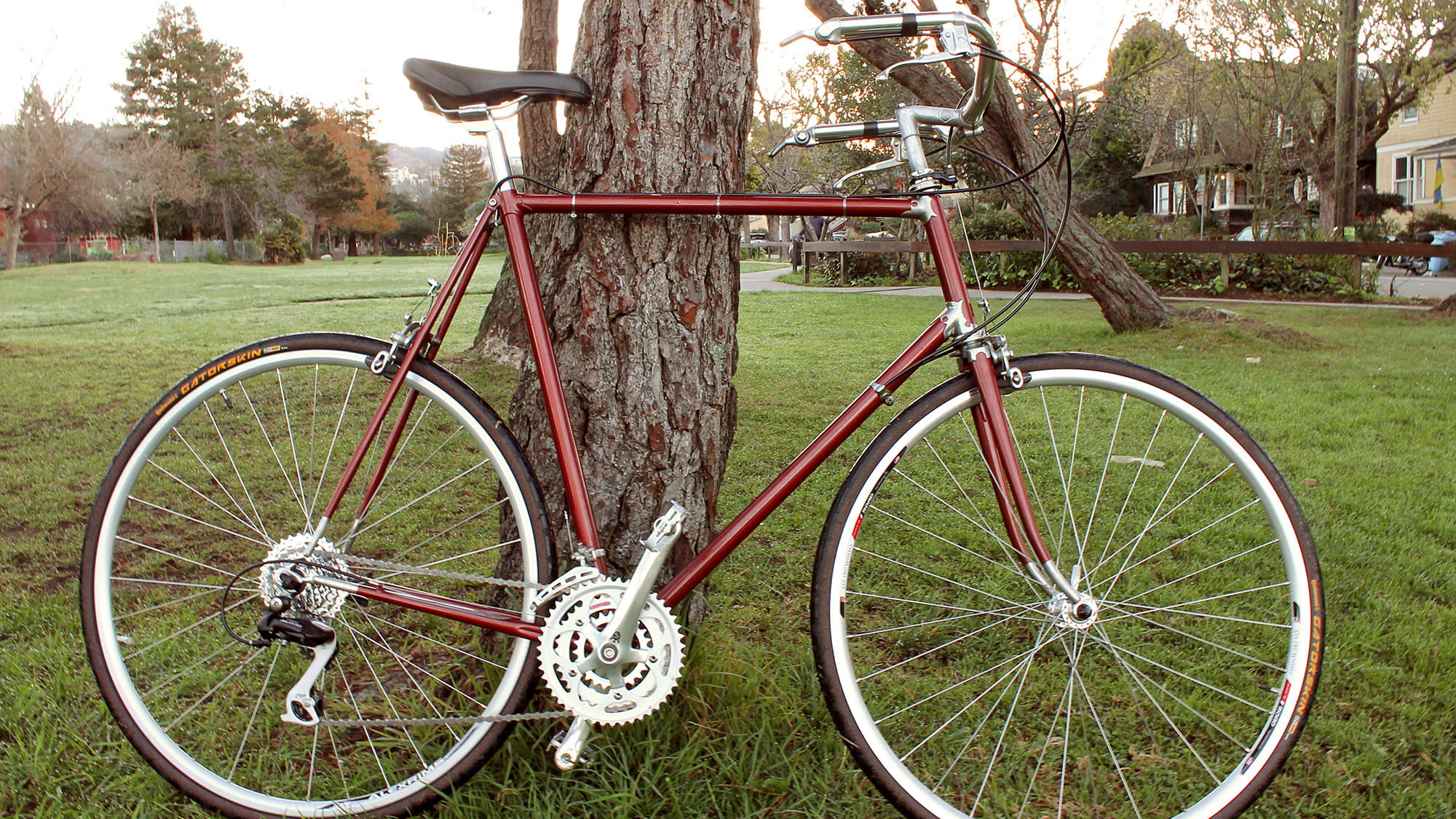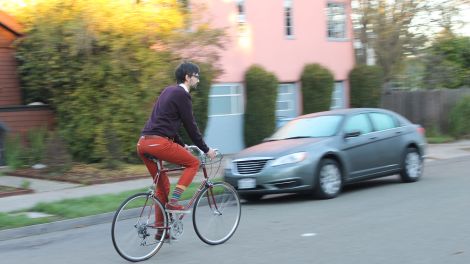
For the past couple months I’ve been trying out cargo bikes, city bikes, and electric bikes, in an effort to replace my stolen sleek and speedy ride with something more appropriate for a dad.
I wrote about the initial phases of my quest here and here. And now it’s over — I finally have a bicycle of my own. So, um, let me just get this out of the way: The forces that led me to my choice were hardly rational, and so far I’ve been too abashed to tally up the total monstrous cost. Still, I hope my shameful story may be useful in guiding others.
My goal at the outset was to find a bike that would be so useful and fun that I’d never want to fire up our new car. And I wanted something with a fundamentally different feel than my last bike: something built for pleasure, not for speed.
That last goal proved to be a lot harder than I’d expected. Walk into just about any bike shop in the U.S., and you’ll see row upon row of racing bikes with low handlebars and high seats that cock the rider aggressively forward, like a sprinter in the blocks. And then, off in a corner, you’ll find a couple more upright bikes — but even those (for the most part) will have a similar frame geometry, with an erect seat post. If you want a seat post that lounges back over the wheel, giving the rider a relaxed posture, you pretty much have to go to Europe, or to one of the few specialty shops that imports Dutch bikes.
What I was looking for, it seemed, was simply un-American. Americans mostly ride for sport: We do long touring rides, or race in triathlons, or bounce down singletrack on mountain bikes. And when we ride in the city, we often bring that same racing mentality to the commute.
There’s a good reason for this: Our roads are generally designed for — and always dominated by — cars. So the people on bikes are generally the young, the fearless, and the testosterone-addled. Europeans cyclists who visit the U.S. sometimes wonder why it looks like everyone is racing. The architecture of the bikes contributes to the racing mentality: When I’m on a machine designed for maximum speed and efficiency, it makes me want to go fast.
Once I started carting my daughter around, I wanted to break with the American norm. I didn’t want a bike that would whisper, “Don’t let that chump pass you! You can make this light!” Instead, I wanted a bike that would say, “Doesn’t the sun feel good today? And is that jasmine blooming? Let’s come to a complete stop at this intersection and find out.” I wanted something effortless and fun, but not instilled with the need for speed.
City bikes
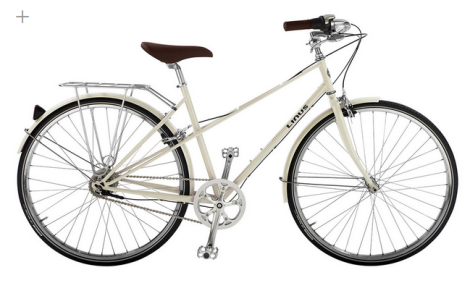
The only mass-market bike I tested out that came close to this ideal was the Linus Mixte. It was fun to ride, and it was easy on the eyes. But it was also cramped: Linus makes just one frame size, recommended for riders under 5’10”. I had an extra seven inches of knees and elbows. This would become a recurring problem. The people in the U.S. who actually buy relaxed-posture bikes tend to be of the female persuasion. Biking just to get around isn’t just un-American, it seems, it’s also un-manly. I simply couldn’t find a city bike that fit me.
Cargo bikes
I tried out a couple of cargo bikes, which felt very similar, and the nice people at Xtracycle lent me one of their Edgerunners for a week. With this bike, I felt truly liberated from the car.
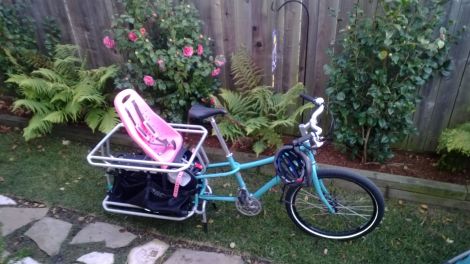
It’s pretty hard to carry stuff on a bike. Once I’d started using the car, I’d marveled at how easy it was to throw groceries in the back or drop my parka in another seat. Having an Xtracycle felt the same way. If I got hot, I could just shove my sweater in the big black pannier. Instead of balancing precariously swinging sacks on the handlebars, they went into the panniers. Pick up a bunch of books at the library? Into the panniers! Daughter wants a ride? Into the panniers!
Actually, that last one doesn’t work so well — but it doesn’t matter, because Xtracycle has put a lot of thought into designing bikes that work with various accessories. The new Xtracycles fit perfectly with a Yepp bike seat, making it easy to click on and off.
My daughter loved riding around in it. The kids from her preschool clustered around to marvel as she pulled on her helmet and strapped in. She begged me to take her for rides just for fun (something which has never happened with the car), and I’d gin up destinations: the library, the store, the pizza restaurant. We’d cruise past those poor drivers searching for parking, pick up some goodies, and then zip off with our cargo (into the panniers!).
There are lots of people out there with blogs devoted to optimizing cargo bikes to haul kids, or anything else. It’s fun, but there are two problems. These bikes are (1) expensive and (2) heavy.
- The bikes themselves start at $1,600, and all the fun components add to that. Those Yepp seats are $200. You can get a stripped down Yuba cargo bike for a little less, but you are still looking at $1,000 or more.
- I’m used to hoisting my bike up stairs, or just lifting it to turn around in a narrow space, but when I tried to lift a cargo bike it was like lifting a dead body (we all have experience with that, right?). You might as well try to lift a motorcycle. I wouldn’t want to take it on the train. That said, it certainly wasn’t “tippy and intense” as I’d presumed. These bikes are steady, if sluggish, underway, and when stopped, they sit solidly on their kickstands.
When you are riding a cargo bike, people see you differently. On my road bike, cars cut me off and honked at me like I was some daredevil punk. But cars came screeching to a halt to make way for me on the Xtracycle. People were so nice it was almost annoying. One time, a woman in an SUV started to pull through an intersection, but saw me coming from almost a half a block away and slammed on the brakes. She waited patiently for me to pedal all the way over so she could yield to me. I’m not sure why this happens, but my theory is that cargo bikes signify family, and people feel good about slowing down to make sure families are protected: Cargo bikes are, perhaps, the two-wheeled version of a duck trailed by a line of ducklings.
Electric bikes
According to one survey, the overwhelming majority of cargo-bike owners eventually gets some kind of electrical motor. That makes sense to me: Going downhill, or up slight inclines, the Xtracycle felt great. But any kind of real hill had me inching along in the granny gear. When I tried an electric bike, everything suddenly seemed closer and easier. I borrowed a Kalkhoff Pro-Connect from The New Wheel and found that my radius significantly expanded. This bike tilted the world downhill from wherever I happened to sit. A 3 percent uphill grade became flat; a flat road turned into a flying descent.
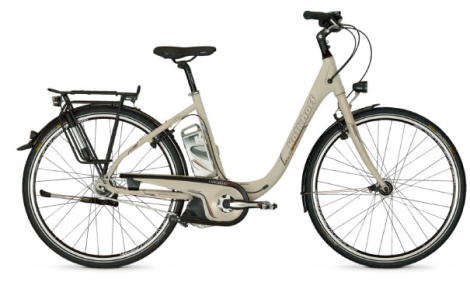
Kalkhoff Pro-Connect C8.
It took me a little while to get used to the way this bike shifted, and the way it selectively added oomph depending on how hard I was pedaling. Once I did, my rides became joyfully speedy. I loved the fact that I never had to tuck in my pant leg: The chain guard and internally geared hub kept it clear of the oil. And I loved the step-through frame that actually fit me.
I also tried an Xtracycle and a Public bike, each with a BionX electrical assist — and these felt a little more natural. The BionX has a button you can punch to provide max power. I loved pulling that trigger when a light turned green, and feeling like I was doing a wheelie out of the starting gate.
But that was kind of the problem: Going fast just made me want to go faster. I don’t know exactly how to explain this, but it didn’t feel quite like the form of bicycling that I knew and loved. The motors and batteries add a lot of weight. Instead of gracefully responding to my every movement, these bikes had a lot of inertia. I found that I wanted to have the assist turned all the way up, all the time.
At least there was less temptation to run stop signs: With a motor, there’s less penalty for coming to a complete stop.
I could definitely see myself getting a motor assist at some point, especially in combination with a cargo bike. But in the short term I wanted to see if I could find something more elegant. If I find myself getting in the car a lot because biking always feels like a slog, I’ll reconsider.
One other thing: There are a lot of exciting electrical options coming on line all the time. These are especially good for people who like to tinker with motors. For people who want someone nearby who can do repairs, you should be sure there’s a bike shop nearby that can help you out.
My own misadventure
As I was doing all this, I started to spend an unreasonable amount of time reading about bikes on the internet and looking at bike parts on eBay. Late one night I came across a lugged-steel frame that was built tall, for a leggy giraffe-oid aberrant like myself. I made what I though was a lowball offer, then forgot about it — until I got a notice telling me it had been shipped.

I hadn’t really thought through the purchase, just acted on impulse, assuming I wouldn’t get it. But maybe this was the way to do it: I could build the bike up just as I wanted.
The problem, I quickly discovered, is that it’s absurdly expensive to buy a bike one piece at a time. If you can mass produce bikes, you can arrange for a steady stream of parts coming in at much cheaper prices.
I decided I’d beat the system by getting used parts. I went down to a nonprofit bike shop that, in return for a small donation, offered me advice on repairs and the opportunity to root through drawers of old components. But even with the advice, it was overwhelming. It takes a lot of expertise, it turns out, to match up vintage bike parts. I left with wheels, a stem, and a seat post, which cost me a total of $90. The next weekend, I dragged a bike-savvy friend down to this shop. He looked around for about five minutes, then walked out. It would take me weeks to assemble the bike, he said, and the end result would be pretty crummy.
I could have admitted that I’d made a mistake and resold the frame. But at that point I was too invested in the project to give up. I decided to take it into my local shop and buy the rest of the parts new. The bike gurus at The Missing Link are the sort of people who immediately know the age and make of any part. It turned out that almost everything I’d bought so far was wrong. With their guidance, I started over.
Now I have a (partially) used bike that cost me — it pains me to do the math, let alone admit this — north of $1,200. But it’s not all bad. I’m still under the budget I allotted for a car-killing bike, and I’ve managed to get an upright bike that fits me. It feels graceful, light, responsive, and relaxed. Just what I was hoping for! I can easily attach a trailer to pull my daughter and the groceries. And most of all, it’s really, really fun.
There’s an old line about racing bicycles being machines designed for the efficient production of pain. But I made this bicycle for a different purpose: When I ride it — to run errands, or pick up my daughter — this machine produces happiness.

